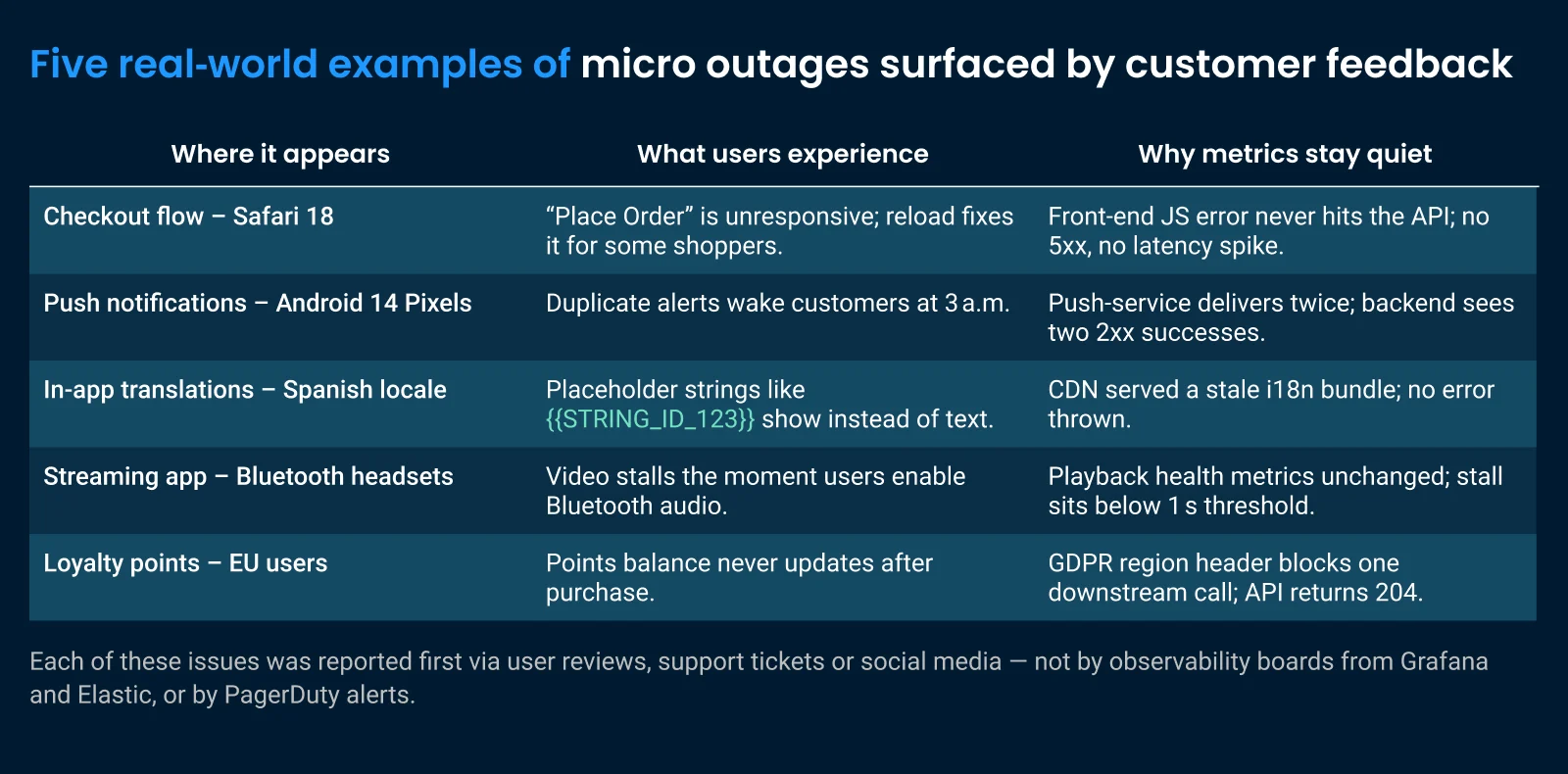Micro outages: Blind spots in observability stacks that unitQ finds in real time

Traditional observability tools excel at turning machine signals — logs, metrics, traces — into dashboards and alerts. Yet customers keep discovering problems those tools never surface because people don’t always trigger the same code paths that synthetics and Service Level Objectives watch. In other words, consumers run into micro outages – short‑lived, localized or workflow‑specific failures that quietly erode trust and revenue long before they grow into a headline‑grabbing incident.
What are “micro outages”
A micro outage is a short‑duration event often challenging to find and fix, delivering the operational pain of an outage in bite‑sized, harder‑to‑debug chunks.Industry analysts note that these incidents can be elusive, localized and may never reach a public status page, yet still break critical user journeys.
Why? Observability dashboards watch machines. Customers, on the other hand, watch experiences.
Micro outages rarely ring an alarm in observability platforms because they affect narrow slices of devices, languages, regions or workflows. By turning every piece of user feedback — app reviews, support tickets, social posts — into structured signals, unitQ lights up the blind spots and automatically directs engineers to the real‑world pain first.
Why machine‑only observability misses micro outages
Users interact with apps in unpredictable and varied ways that traditional observability tools often struggle to capture. Metrics tell you what happened at the system level, but rarely why a specific cohort is stuck, confused or churning. Only the humans on the other side, however, notice the pain.
Micro outages frequently:
Affect only one OS/browser version, geography or feature flag.
Produce 200‑OK status code responses and no spike in error budgets.
Hit only one customer tier (e.g., enterprise), keeping overall error rates unchanged.

Turning micro‑outage clues into root‑cause answers with unitQ
When a handful of frustrated customers post identical complaints — whether in an app-store review, support ticket, live chat or social mention — that’s your signal that a micro-outage is creating invisible blockers between your users and success. unitQ transforms those scattered human voices into a precision-guided toolkit that plugs directly into your existing observability stack.
Here's how:
Unified feedback ingestion
Sources: App stores, in-app chats, CRM tickets, email, social media, even call-center transcripts and more
Scale: Tens of thousands of comments per minute, across 100+ languages
Result: A single, real-time stream of raw user feedback ready for analysis
Automated normalization, categorization
Language detection & translation: No more blind spots in non-English markets
Entity extraction: Identifies releases, features, OS versions, device models and geo-tags
ML clustering: Groups complaints like “checkout button dead” or “duplicate push alerts” into high-confidence issue buckets
Smart prioritization
Signal vs. noise: Filters out one-off comments and highlights clusters that exceed customizable, alerting thresholds
Customer value scoring: Combines volume, sentiment and customer value (e.g. enterprise vs. freemium) to surface the highest-impact micro-outages first
Regulatory flags: Tags feedback likely tied to fraud, compliance or data-privacy rules so you can address both UX pain and policy risk
Automated Ops and engineering workflows
Alert routing: Trigger PagerDuty, Slack or Microsoft Teams notifications only when real customers report broken workflows—no more noisy false alarms
Issue creation: Auto-generate Jira or ServiceNow tickets pre-filled with reproduction steps culled from customer quotes
Executive dashboards: Deliver audit-ready reports showing every resolved micro-outage, its MTTR and the downstream improvements in revenue, retention and regulatory compliance
Continuous improvement and closed-loop validation
Post-fix feedback monitoring: Watch for a drop in related complaints to confirm full remediation
ML retraining: Feed corrected tickets back into unitQ’s models to sharpen future detection of similar micro-outages
Real-world examples of unitQ at work fighting micro-outages
Bank check deposit never appears in my account
Customer reports: “I deposited a check two days ago, but my balance still hasn’t updated.”
What unitQ does: Detects a cluster of Android-user complaints about missing deposits, identifies that only one OS version is affected, and surfaces the pattern to the right engineering teams, letting them zero in on the failing API endpoint in hours, rather than weeks.
Auto-insurance ID card won’t download on iPhone
Customer reports: “Tapping ‘Download ID’ spins forever on my iPhone.”
What unitQ does: Correlates App Store reviews, support tickets and tweets on X all describing the same freeze on iOS devices, extracts the common device model and iOS version, and pushes a prioritized alert to the right team to address, so they can roll out a fix before critical renewals are delayed.
By embedding unitQ’s real-time user-feedback layer into your observability practice, you turn invisible micro-outages into clear, actionable insights so that every customer comment becomes a launchpad for faster fixes, happier customers and rock-solid compliance.
What’s more, because feedback arrives in dozens of languages that unitQ automatically translates into English, your organization is empowered to detect micro outages globally, and not just limited to a single market or locale — something raw metrics can’t flag.
Building a micro‑outage‑ready observability practice with unitQ
Collect every voice: Centralize reviews, chats, calls and social posts; translate them automatically so nothing slips through language gaps with unitQ.
Categorize at scale: Use unitQ machine learning to spot patterns (“login loop on iOS 17.5”) faster than humans reading tickets one by one.
Correlate with telemetry: Link each feedback cluster to traces, feature flags and deploy IDs to prove or disprove causality with unitQ
Close the loop: Automatically feed confirmed micro‑outage signals to engineering and support, then watch feedback volume fall as fixes ship.
The unitQ payoff
Catching micro outages early means:
Higher revenue – fewer silent checkout failures.
Happier customers – no more “death by a thousand paper cuts.”
Faster engineering cycles – clear, user‑validated priorities for hot fixes.
Observability that stops at machine data is only half a stack. Fold in real‑time user feedback and you illuminate the micro outages hiding in the shadows before they become tomorrow’s macro outage. Best of all, spotlighting micro outages before they escalate reinforces stakeholder confidence — demonstrating that you’re in control of compliance, customer trust and brand reputation.
About unitQ
unitQ, the leading customer insights platform, enables businesses to pinpoint real customer issues and needs instantly with AI. AI agents automatically transform customer feedback from diverse channels — such as support tickets, product analytics, app stores, social media, surveys and more — into actionable insights in real time.
Companies can drive product innovation, streamline issue resolution and elevate customer experiences, all guided by the authentic voice of their customers. AI agents aggregate and categorize all customer feedback into thousands of granular categories, ensuring organizations always understand precisely what matters most to their users.
Robust dashboards and alerts monitor customer experience trends and competitor offerings in real time. Accelerate product development cycles by closely tracking customer reactions to launches, identifying top feature requests and prioritizing roadmaps based on key performance indicators such as retention, Net Promoter Score (NPS) and Customer Satisfaction (CSAT).
Category-leading companies — including Bumble, Zendesk, PayPal, and Uber — trust unitQ to drive growth, reduce churn and build lasting brand loyalty.
David Kravets is Senior Content Marketing Manager at unitQ.


